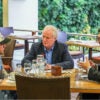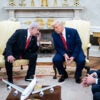Did you know when you text someone that you’ve landed at the airport, you’re using far more advanced technology than your plane’s air traffic controller?
It’s a shameful fact that some of the methods they rely on today have not changed since the 1930s. Over 60 countries—including all the developed nations—have modernized their systems but ours is stuck in the past thanks to politics and special-interest turf wars.
To find out why, I asked Bob Poole.
The Daily Signal depends on the support of readers like you. Donate now
Poole is America’s foremost expert on private-sector solutions to transportation issues. He’s advised virtually every presidential administration since Ronald Reagan’s and is the founder of and director of transportation policy at the Reason Foundation.
He describes an antiquated air traffic control system that costs airlines and passengers $33 billion per year in wasted time and excess operating costs. It’s also making us less safe.
“There are safety issues in the sense that you get the highest safety from having the best technology, the most modern things, and we are lagging so far behind. We don’t have things that are standard practice in Canada, like digital communication, digital messaging between controllers and pilots in real time, instead of voice transmissions,” said Poole.
Far from being the envy of the world, the U.S. system for guiding aircraft is a backward analog relic in a digital age. Congress has the power to change this, but needed changes were dropped from a Federal Aviation Administration reauthorization bill.
Poole points out that over the past 30 years, 60 different countries removed air traffic control from the entanglements of government agency bureaucracy and established, essentially, standalone utility services subject to government oversight but not management.
That independence has led to innovation and major technical upgrades. Meanwhile, the United States is lagging far behind other nations, as we still use 1930s-era radio and 1950s-era radar.
“In an age of text, we’re still … on voice analog, and we don’t have air traffic control, to speak of, over the oceans because there’s no place to put radar in the ocean,” said Poole.
It gets worse. We live in the information age, but we still have air traffic controllers walking information across the room on pieces of yellow paper strips.
“It’s got the flight number and the airline and a few other bits and pieces about the track. When a plane is given clearance to take off, it goes from the controller that controls the actual permission to land, a runner takes that strip to the next controller,” said Poole.
Canada and dozens of other nations prove the technology exists to make air traffic much safer and operate more smoothly. And Poole says the controllers themselves, the pilots, and flight attendant unions and airlines are all for it, but other government unions are afraid of the change modernization might bring.
“Every other government union sees this as a slippery slope. If we take 30-some thousand people out of the FAA, it could be done everywhere,” he added. The other big enemy of change are the corporate jet owners, who pay miniscule fees under the current regime.
This should be a public scandal. Improved safety and efficiency are being held hostage by status quo special interests, and those protests are loud enough that Congress shelved legislation to bring our air traffic control structure closer to the 21st century.
A better, safer air traffic control system could be right at our fingertips. But that progress is in a holding pattern until we demand that Congress act. Enough is enough.





























